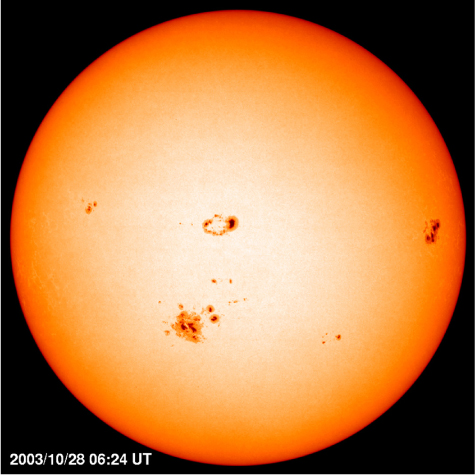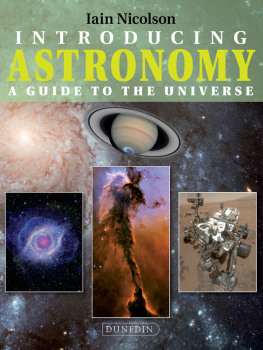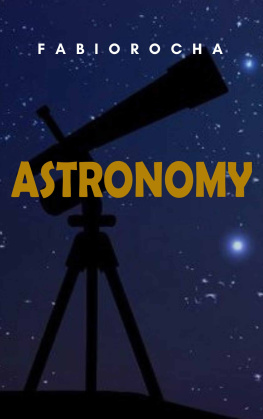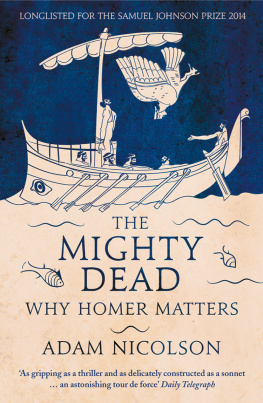Iain Nicolson - Introducing Astronomy
Here you can read online Iain Nicolson - Introducing Astronomy full text of the book (entire story) in english for free. Download pdf and epub, get meaning, cover and reviews about this ebook. year: 2021, publisher: Dunedin Academic Press Ltd, genre: Children. Description of the work, (preface) as well as reviews are available. Best literature library LitArk.com created for fans of good reading and offers a wide selection of genres:
Romance novel
Science fiction
Adventure
Detective
Science
History
Home and family
Prose
Art
Politics
Computer
Non-fiction
Religion
Business
Children
Humor
Choose a favorite category and find really read worthwhile books. Enjoy immersion in the world of imagination, feel the emotions of the characters or learn something new for yourself, make an fascinating discovery.
- Book:Introducing Astronomy
- Author:
- Publisher:Dunedin Academic Press Ltd
- Genre:
- Year:2021
- Rating:3 / 5
- Favourites:Add to favourites
- Your mark:
- 60
- 1
- 2
- 3
- 4
- 5
Introducing Astronomy: summary, description and annotation
We offer to read an annotation, description, summary or preface (depends on what the author of the book "Introducing Astronomy" wrote himself). If you haven't found the necessary information about the book — write in the comments, we will try to find it.
Introducing Astronomy — read online for free the complete book (whole text) full work
Below is the text of the book, divided by pages. System saving the place of the last page read, allows you to conveniently read the book "Introducing Astronomy" online for free, without having to search again every time where you left off. Put a bookmark, and you can go to the page where you finished reading at any time.
Font size:
Interval:
Bookmark:
Other Titles in this Series:
Introducing The Planets and their Moons (2014)
Introducing Geology A Guide to the World of Rocks (Second Edition 2010)
Introducing Geomorphology (2012)
Introducing Meteorology ~ A Guide to the Weather (2012)
Introducing Mineralogy (2014)
Introducing Oceanography (2012)
Introducing Palaeontology A Guide to Ancient Life (2010)
Introducing Sedimentology (2014)
Introducing Tectonics, Rock Structures and Mountain Belts (2012)
Introducing Volcanology ~ A Guide to Hot Rocks (2011)
For further details of these and other Dunedin
Earth and Environmental Sciences titles see
www.dunedinacademicpress.co.uk

INTRODUCING
ASTRONOMY
A GUIDE TO THE UNIVERSE
Iain Nicolson

Imprint page
First published in 2014 by
Dunedin Academic Press Ltd
This ebook edition published 2014
Head Office:
Hudson House
8 Albany Street
Edinburgh EH1 3QB
ISBNs:
Print edition (paperback): 9781780460291
Epub edition: 9781780465159
Kindle edition: 9781780465166
Copyright 2014 Iain Nicolson
The right of Peter Ian Nicolson to be identified as the author of this work has been asserted by him in accordance with sections 77 & 78 the Copyright, Designs and Patents Act 1988.
A catalogue record for this book is available from the British Library.
All rights reserved by the publisher under International Copyright Conventions. By payment of the necessary fees you have been granted a non-exclusive, non-transferable licence to access and read the text of this e-book on-screen. No part of this text may be reproduced, transmitted, down-loaded, decompiled, re-engineered or stored in any information retrieval system in any form or by any means except in accordance with the terms of the licence granted to you. If in doubt as to what use may be permitted by the non-exclusive licence that you have purchased, please contact the publisher, Dunedin Academic Press Ltd.
www.dunedinacademicpress.co.uk
Acknowledgements
I am grateful to all of the many institutions and individuals who have kindly granted permission to reproduce images. I should also like to thank several reviewers for reading the manuscript and for their helpful and constructive comments and suggestions. Any errors or inadequacies that remain are, of course, my own responsibility.
My thanks are also due to those working with Dunedin Academic Press. In particular, I wish to thank Anthony Kinahan for initiating the project and for his unstinting support and advice; David McLeod, who has designed and typeset the book; copy-editor Anne Morton for her meticulous editing of the text and for her invaluable suggestions and advice; and the illustrator, Sandra Mather, for so skilfully translating my rough sketches into high-quality artworks and diagrams.
Finally, I thank my wife, Jean, for her support, encouragement and advice throughout the preparation of this book.
Iain Nicolson, June 2014
Note: I have tried to minimise the use of technical terms, but those that are necessary are explained in the Glossary and are highlighted in bold type on first appearance.
Cover Image credits:
Top, Saturn aurora: NASA, ESA, J. Clarke (Boston University), and Z. Levay (STScI);
Left hand, the Helix Nebula: NASA/JPL-Caltech;
Centre, a tower of cold gas and dust in the Eagle Nebula: NASA, ESA and the Hubble Heritage Team (STScI/AURA);
Right hand, Curiosity Rover on Mars: NASA/JPL-Caltech/Malin Space Science Systems; Background, the Pinwheel galaxy: European Space Agency & NASA. Acknowledgements: Project Investigators for the original Hubble data: K.D. Kuntz (GSFC), F. Bresolin (University of Hawaii), J. Trauger (JPL), J. Mould (NOAO), and Y.-H. Chu (University of Illinois, Urbana); Image processing: Davide De Martin (ESA/Hubble); CFHT image: Canada-France-Hawaii Telescope/J.C. Cuillandre/Coelum; NOAO image: George Jacoby, Bruce Bohannan, Mark Hanna/NOAO/AURA/NSF.
List of tables and illustrations
Preface the science of the universe
Astronomy is the science that investigates the universe around us. It is, arguably, the oldest of the sciences, for humankind must have been aware, long before written records began, of the Sun, Moon, stars and naked-eye planets and their movements in the sky. Gradually, sky watchers began to chart their positions, identify patterns in their behaviour, and use that information on the one hand for practical purposes, to record the passage of time, the recurrence of the seasons, and as an aid to navigation and on the other, with increasing sophistication over the centuries, to attempt to understand the nature of these objects and the scale of the universe in space and time.
For millennia, these studies were restricted to what could be seen directly by the unaided human eye. That changed, at the beginning of the seventeenth century, with the invention of the telescope, which enabled astronomers to see details on the surfaces of the Sun, Moon and planets, to detect objects far fainter than the eye alone could see and, therefore, to penetrate much deeper into space. Another key step, in the nineteenth century, was the invention of the spectroscope, a device that allowed astronomers to analyse in detail light arriving from distant objects, and to investigate their chemical and physical properties. In that same century, photography arrived on the scene, enabling astronomers to record permanent images and to detect objects that were too faint to be seen by the human eye even with telescopic aid. During the twentieth century and into the twenty-first, progressively larger telescopes, and advances such as electronic imaging, the computer analysis of data, and the ability to place telescopes in orbit beyond our atmosphere, and to send spacecraft to the planets and moons of our immediate cosmic neighbourhood, have utterly transformed the depth and breadth of the science.
But astronomy remains essentially an observational science. Whereas a chemist or physicist can set up an experiment in a laboratory, change the conditions and measure the outcome, astronomers cannot touch, or experiment directly with, stars or galaxies. Instead, they have to piece together their picture of the universe by detecting, measuring and analysing light and other forms of radiation that are coming our way from the depths of space..
Part of astronomys enduring fascination is that it grapples with fundamental questions concerning the origin, evolution and ultimate fate of planets, stars, galaxies and the universe as a whole, and touches on that most intriguing of conundrums: is life unique to the Earth or a widespread phenomenon? Another part of its great attraction is its accessibility: we can all go out and explore the beauty of the night sky for ourselves. This book outlines and explains what astronomy has to tell us about the nature of planets, stars, galaxies and the universe, and highlights some of the ways in which astronomers have arrived at this body of knowledge.
Our place in space
We look out into the vastness of the and their natural satellites (moons), a host of smaller bodies, and quantities of gas and dust, all of which revolve around the Sun, under the influence of its powerful gravitational pull.

Font size:
Interval:
Bookmark:
Similar books «Introducing Astronomy»
Look at similar books to Introducing Astronomy. We have selected literature similar in name and meaning in the hope of providing readers with more options to find new, interesting, not yet read works.
Discussion, reviews of the book Introducing Astronomy and just readers' own opinions. Leave your comments, write what you think about the work, its meaning or the main characters. Specify what exactly you liked and what you didn't like, and why you think so.









![Iain Maitland [Iain Maitland] - Mr Todd’s Reckoning](/uploads/posts/book/141709/thumbs/iain-maitland-iain-maitland-mr-todd-s.jpg)


